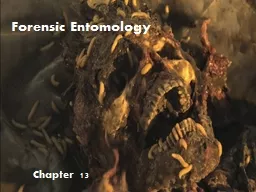

Determining postmortem interval PMI using necrophagous insects or other arthropods Carrioneating insects often associated with human remains Invertebrates are pretty successful Numbers of different species ID: 920547
Download Presentation The PPT/PDF document "Chapter 13 Forensic Entomology" is the property of its rightful owner. Permission is granted to download and print the materials on this web site for personal, non-commercial use only, and to display it on your personal computer provided you do not modify the materials and that you retain all copyright notices contained in the materials. By downloading content from our website, you accept the terms of this agreement.
Slide1
Chapter 13
Forensic Entomology
Slide2Determining postmortem interval (PMI) using
necrophagous insects (or other arthropods).Carrion-eating insects often associated with human remains.
Slide3Invertebrates are pretty successful!
Numbers of different species
Living things on Earth
Slide4Slide5Slide6Slide7Slide8Slide9Slide10Incomplete metamorphosis
Slide11Slide12Some insects feed on the products of decomposition.
Others feed on these initial feeders.The succession of insect predators follows a predictable pattern for a given habitat, season, etc.
Slide13Blowflies are usually first. (Order
Diptera)Eggs are laid in body orifices (nose, ears, eyes, mouth).
Slide14Slide15Feeding maggots plus bacterial decomposition can raise the body temperature.
Ants, wasps (Order Hymenoptera), and beetles (Order
Coleoptera) begin arriving to feed on other insects or the dead body.
By the end of the decay stage of decomposition, the insects have left and the corpse has been reduced to 10% of its original weight.
Slide16Bluebottle blowfly
Effects of Temperature
Slide17Growth rate is expressed in
temperature-time units.Degree-hours or degree-days measure the amount of energy absorbed by the insect (which helps them grow and develop).Time (in hours) x Temperature (degrees
Celcius)= Accumulated degree-hours (ADH)See page 389 in text for example
Slide18The Forensic Entomologist still needs to estimate the time it took for the insects to find the body and begin laying eggs. This is dependent on things like environmental conditions, season, location of body, etc.
Other variables…
Body in a different microclimate than the temp. you’re using
More blood = faster arrival time of fliesParts of body exposedBurn victims attract flies quickerClothes, insect repellant, burial, water, plastic coveringsMasses of maggots increase temperature…this would accelerate decayToxins and drugs
Slide19Slide20Forensic Entomology
Interactive
Slide21Interactive game
Slide22***Most accurate if body is found within 24 hours of death
Algor
mortis; cooling of the body after death
Body cools at approx. 1-1.5 degrees per hour until environmental temp is reached. Researcher must consider factors such as… Environmental temp. Type of clothing Is clothing wet? (aids cooling) Air movement (aids cooling) Layers of clothing (prevents cooling) Surface area/body mass ratio (small bodies will cool more quickly)Glaister formula gives hours elapsed:98.4 – internal temp________________ 1.51. Physical methods of determining time of death
Slide23B.
Livor mortis; purple or red discoloration of the skin after death, caused by pooling of the blood due to gravity.
Begins .5 hr after death, most evident within 12 hr. After 12 hr discoloration will not move regardless of how the body is handled or moved.
Areas in contact with ground (or anything) show no discoloration because capillaries are compressed.
Slide24C. Rigor mortis; stiffness in skeletal muscles 2-3 hrs after death, lasting until ~30 hrs, then disappearing in the same order of onset.
Smaller muscles first. Affected by temp, dehydration, condition of muscles, use prior to death, etc.
Slide25The table below summarizes the key changes which take place within 48 hours of death:
Time since death: …. Change observed1-2 hours: ………Early signs of lividity.
2-5 hours: ………Clear signs of lividity throughout body.
5-7 hours: ………Rigor mortis begins in face.8-12 hours: …….Rigor mortis established throughout the body, extending to arms and legs12 hours: ……….Body has cooled to about 25°C internally.20-24 hours: …..Body has cooled to surrounding temperature.24 hours: ……….Rigor mortis begins to disappear from the body in roughly the same order as it appeared.36 hours: ……….Rigor mortis has completely disappeared.48 hours: ……….Body discolouration shows that decomposition is beginning.
Slide26Decomposition Process
Autolysis; cells rupture, releasing cellular fluids
First observed after 1-3 days…fluid filled blisters on skin and “skin slippage”
deglovingPutrefaction; destruction of soft tissue by bacteriaGreenish color skin, bloating from decomposition gases such as ammonia and methane. Odor from butyric and propionic acids. Days 4-10.